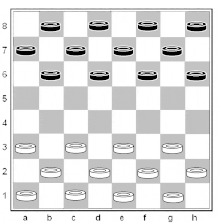Russian board game
Bashni (Russian: ба́шни, towers), also known as column draughts, multi-level checkers, and rarer Chinese checkers, is a variation of draughts, known in Russia since the 19th century. The game is played according to the basic rules of Russian draughts, with the main difference being that draughts being jumped over are not removed from the playing field but are instead placed under the jumping piece (draught or tower).
The resulting towers move across the board as one piece, obeying the status of the upper draught. When a tower is jumped over, only the upper draught is removed from it. If, as a result of the combat, the top draught changes colour, ownership of the tower passes on to the opposing player.
Based on Bashni, but according to the basic rules of English draughts, world chess champion Emanuel Lasker developed the draughts game "Laska" and, in 1911, published its description. Lasker described towers that can only be "double-layered": i.e. there can be no alternation of colors. He also showed that during the game the number of game pieces either remains constant or decreases. Column draughts are a subject of interest for the mathematical Sciences: combinatorics, theory of paired zero-sum games, etc.
History
It is believed, the first description of column draughts was presented in the article "Towers or tours" of the "Collection of games for family and school" compiled by Valerian Alexandrovich Viskovatov, and published in 1875 in St. Petersburg. A famous theorist and historian draughts Davyd I. Sargin., being the editor of the chess and draughts sections in many Russian Newspapers repeatedly reprinted the article and published its own research pole pieces. One of the most complete descriptions of column draughts is given in his fundamental work "the Antiquity of the games of checkers and chess", published in Moscow in 1915[2].
A significant role in the dissemination column draughts belongs to enthusiasts of the Leningrad production Association "Krasnaya Zarya" headed by researcher table games, teacher of adult education and the promoter of Aleksandr G. Borovikov (23 June 1931 – 8 March 2017 g). A. G. Borovikov for many years (from 2000 to 2015), co-editor of the magazine "Koster" in which he led the column "on the checkered Board" and told a fascinating story not only about the varieties of column draughts, but also other Board games.
Yuri Pavlovich Filatov, one of the first initiators of the go-movement in the USSR, highly valued column draughts and actively promoted them.
Notation
Games and positions are recorded using a special notation – algebraic notation. The vertical columns of squares are labeled from a to h. The horizontal rows of squares are numbered 1 to 8 starting from White's side of the board. Thus each square of the board has a unique identification of file letter followed by rank number.
- Move from e3 to d4 are recorded as e3-d4.
- Move with capture are recorded as c5:e3 (used a colon :).
| a | b | c | d | e | f | g | h | | | 8 | | 8 | | 7 | 7 | | 6 | 6 | | 5 | 5 | | 4 | 4 | | 3 | 3 | | 2 | 2 | | 1 | 1 | | a | b | c | d | e | f | g | h | |
Starting position. White move first.
|
1. c3-b4 b6-c5
2. b4-a5 a7-b6
3. b2-c3 c5-b4
4. a3:c5:a7 c7-b6
5. a5:c7:e5 f6:d4:b2
6. a1:c3 d8-c7
For record a position with column Men are recorded as «О», King as «1». A captured opponent's piece is recorded under note «/».
For example:
White: с1 – 1/0000, d6 – 000000, f4 – 0000; black: а1 – 110101/1, b2 – 00.
Official rules
First official rules was adopted by Assembly members of the Saint Petersburg regional Club 16–17 March 2002.


